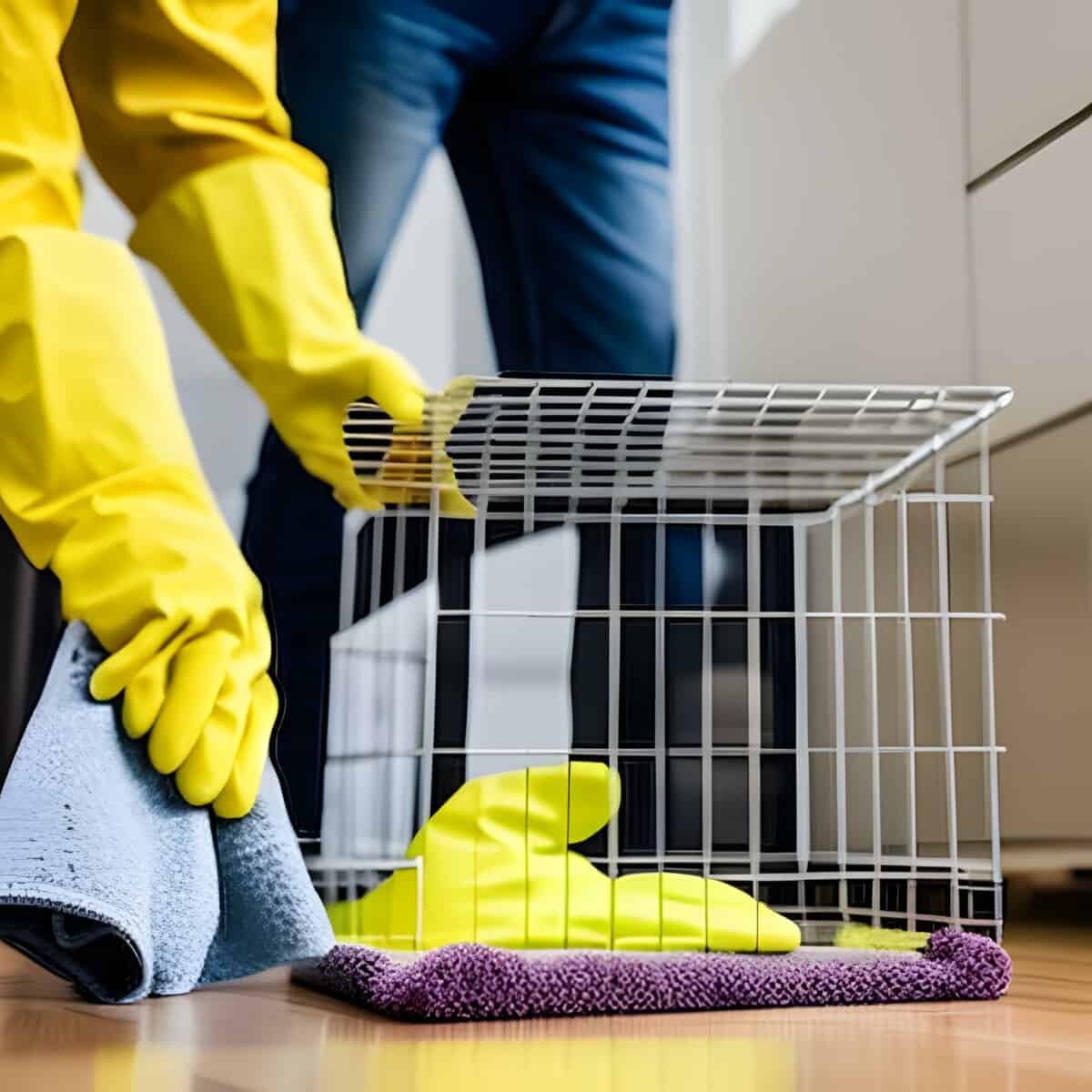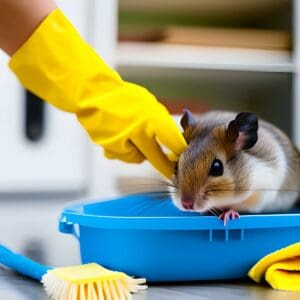Dirty hamster cages harbor bacteria, odors, and waste, and can lead to health issues for the hamster and owners.
There are things you can do daily such as cleaning the hamster bathroom area, food, and water bowls.
Things you can do weekly include bedding replacement, scrubbing the enclosure, and toys and other objects wash.
We created this How to Clean a hamster cage guide to help you and your hamster enjoy precious time in a clean and safe environment.
Let’s get to cleaning.
How to Clean a Hamster Cage: Table of Contents
1. Gather the Necessary Supplies

Before you begin cleaning your hamster cage, gather the necessary supplies to ensure that the process runs smoothly
You will need:
Cleaning Solutions
When it comes to cleaning solutions, there are a few options to choose from.
Vinegar is a natural and effective cleaner that can be used to clean your hamster’s cage.
Dish soap is another option that can be used to clean the cage.
Using cleaning solutions specifically designed for small animal cages is a recommended choice.
You can find these products at pet stores, and they are formulated to be safe for your hamster These solutions are usually designed to effectively clean and disinfect the cage without posing any harm to your hamster.
If you want to use a stronger cleaner, bleach can be used to disinfect the cage. However, make sure to use it in a well-ventilated area and rinse the cage thoroughly to avoid any harmful residue.
Whatever cleaning solution you decide to use, make sure to dilute it with water to avoid any harm to your pet.
Protective Gloves
It’s important to protect yourself when cleaning your hamster’s cage. Avoid touching the cage or any waste without gloves to protect yourself from any bacteria or viruses that could be present.
Latex or nitrile gloves work well for this purpose. Make sure to dispose of the gloves after each cleaning session to avoid spreading any germs.
Replacement Bedding
You will need to replace bedding that is stained or smells bad to keep your pet comfortable and content.
Make sure you purchase a type of bedding that is safe and made for hamsters. There are many options available, including wood shavings, paper bedding, and fleece bedding. Choose the one that works best for you and your pet.
Hamsters may have individual preferences when it comes to bedding.
When selecting bedding, avoid materials that are potentially harmful to your hamster, such as cedar and pine shavings, which can release aromatic oils and scratch them.
Scrubbing Tools
Cleaning your hamster’s cage can be a challenging task, especially when it comes to hard-to-reach places. You will require a scrub brush, a sponge, and cloths to allow you to clean all the nooks and crannies of your hamster’s cage.
A toothbrush can also be useful for cleaning small areas. Make sure to clean all surfaces, including the walls, floor, and any toys or accessories in the cage.
2. Remove Your Hamster Safely
Before you can start cleaning your pet’s cage, you need to remove your hamster from their habitat and move them to a safe and secure location. Place your hamster in a secure space that is quiet and comfortable while you clean the cage.
3. Empty and Clean the Cage Contents
The first step in cleaning your hamster’s cage is to empty its contents.
This includes bedding, food bowls, and water bottles. Dispose of any waste in a bag tied off securely and leave outside to avoid any unwanted smells.
Remove any toys and accessories from the cage and be sure to clean them individually. Don’t forget any water bottles and food dishes.
4. Scrub the Cage Walls and Floor
Now that the cage is empty, use a scrub brush to thoroughly clean the walls and floor of the cage.
Use mild soap and water, vinegar (diluted) or a pet-safe disinfectant to clean all surfaces.
5. Disinfect the Cage
Use a cleaning solution like bleach diluted 1:10 mixed with water to disinfect the cage surfaces.
Make sure you leave the solution on for a few minutes before rinsing thoroughly with water. The disinfectant is essential to eliminate any germs or bacteria that may be present in the cage.
6. Rinse and Dry the Cage
Once you have disinfected the cage, rinse it thoroughly with water to remove any residue or remaining disinfectant.
Towel dry the cage or dry it in the sun before replacing bedding and accessories.
Don’t forget to fill up food bowls and water bottles with fresh contents, and place your Hamster safely back in their clean habitat.
Why Cleaning Your Hamster Cage is Important
One of the primary reasons for cleaning your hamster cage is to maintain a healthy environment and avoid hamster health issues in your furry friend.
A clean cage can help prevent the buildup of harmful bacteria and other microorganisms that can cause respiratory infections and other health problems.
Hamsters are prone to producing odors, and if their cage isn’t cleaned and maintained properly, the odors can get worse.
To prevent odors and bacteria buildup in the cage, make it a habit to clean the cage at least once a week.
You can also use a cleaning solution like vinegar or dish soap mixed with water to wipe down the cage and accessories to ensure that any bacteria, mold, or fungi are killed and removed. Keeping the cage clean and odor-free will not only make it a more pleasant place for your hamster to live, but it will also make it a more enjoyable environment for you to be around.
A hamster can become stressed if their cage is not properly maintained, which can lead to health issues. By ensuring your pet’s cage is clean and free from odors, you can help keep them calm and content. This is especially important if you have a hamster that is easily agitated or prone to anxiety.
If you are wondering if you should also clean your hamster, please read our Hamster cleaning guide fists to avoid any harm to your pet.
Vet Q&A
Q: How to clean a hamster cage with vinegar?
A: Create a cleaning solution by mixing equal parts of water and white vinegar. You can use a spray bottle to apply the solution.
Use the vinegar solution to spray every inch of the cage, including the internal and external surfaces, bars, shelves, and accessories.
Allow the solution to sit for a few minutes to help break down dirt and grime. Then, scrub the cage using a sponge or brush to remove any residue. Rinse the cage thoroughly with clean water to remove any remaining vinegar solution.
After rinsing, make sure to thoroughly dry the cage to prevent any moisture buildup. You can use a clean towel or allow it to air dry in a well-ventilated area before adding fresh bedding and returning your hamster to the cage.
Avoid using vinegar on the metal cage bars as the hamster may ingest it while biting, which can cause health issues due to the acidic nature of vinegar].
Stick to using vinegar for non-metal parts of the cage.
Q: Why is my hamster stressed after cleaning cage?
A: Hamster can be stressed due to:
- changed position of the cage in the room or rearranged items within the cage, such as toys, food bowls, bedding, or nests
- Sometimes, hamsters can exhibit signs of “cage rage” when they become excessively stressed due to changed living conditions. This can include being agitated, irregular sleep patterns, excessive or reduced activity levels, and other signs of stress.
Not all hamsters will necessarily become stressed after cage cleaning. However, to minimize stress during and after cleaning, it is recommended to follow these tips:
Limit changes to the cage’s layout: Try to maintain consistency in the positioning of items within the cage. Avoid rearranging the cage during each cleaning session to provide a sense of familiarity for the hamster.
Spot clean: If the cage walls are not dirty and there is no bad odor, you can opt for spot cleaning rather than a full cage cleaning. This reduces the level of disruption and helps prevent unnecessary stress for the hamster.
Provide a stress-free environment: Ensure that the hamster’s cage is spacious, well-equipped with toys and hiding spots, and offers a comfortable and safe environment. This helps create a sense of security for the hamster, reducing stress levels overall.
For more information on hamster care, please refer to our Hamster Care Guide.
My Senior Paws is a participant in the Amazon Services LLC Associates Program, an affiliate advertising program designed to provide a means for sites to earn advertising fees by advertising and linking to Amazon.com. We also participate in other affiliate programs which compensate us for referring traffic.




